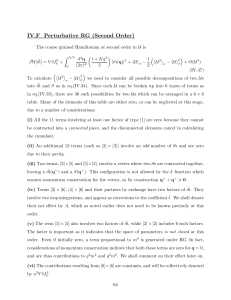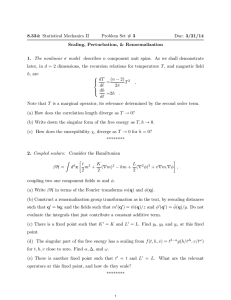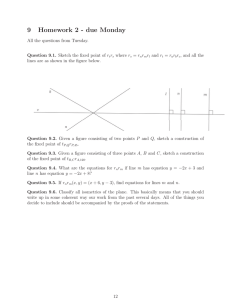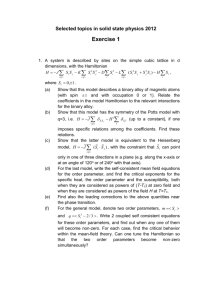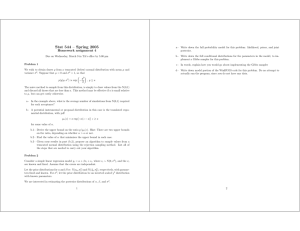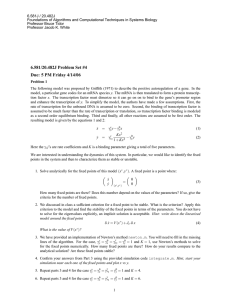Document 13470565
advertisement
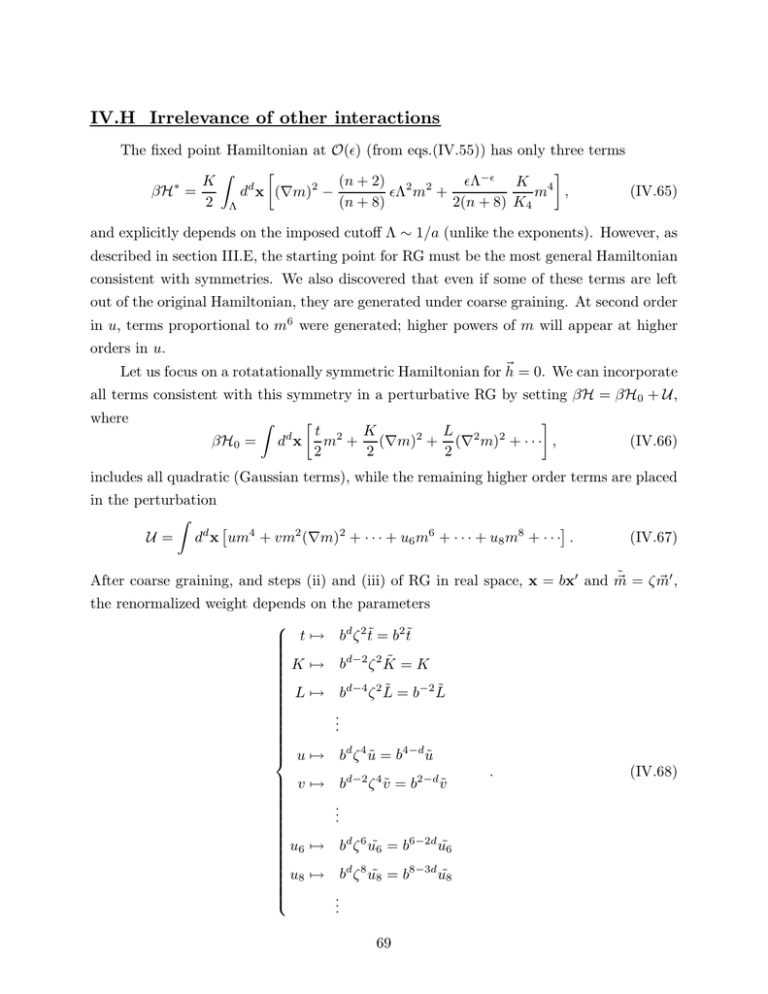
IV.H Irrelevance of other interactions The fixed point Hamiltonian at O(ǫ) (from eqs.(IV.55)) has only three terms Z K (n + 2) 2 2 ǫΛ−ǫ K 4 ∗ d 2 βH = (IV.65) d x (∇m) − ǫΛ m + m , (n + 8) 2(n + 8) K4 2 Λ and explicitly depends on the imposed cutoff Λ ∼ 1/a (unlike the exponents). However, as described in section III.E, the starting point for RG must be the most general Hamiltonian consistent with symmetries. We also discovered that even if some of these terms are left out of the original Hamiltonian, they are generated under coarse graining. At second order in u, terms proportional to m6 were generated; higher powers of m will appear at higher orders in u. Let us focus on a rotatationally symmetric Hamiltonian for �h = 0. We can incorporate all terms consistent with this symmetry in a perturbative RG by setting βH = βH0 + U, where βH0 = Z L 2 2 t 2 K 2 d x m + (∇m) + (∇ m) + · · · , 2 2 2 d (IV.66) includes all quadratic (Gaussian terms), while the remaining higher order terms are placed in the perturbation Z U = dd x um4 + vm2 (∇m)2 + · · · + u6 m6 + · · · + u8 m8 + · · · . (IV.67) After coarse graining, and steps (ii) and (iii) of RG in real space, x = bx′ and m̃ � = ζm � ′, the renormalized weight depends on t 7→ K 7→ L 7→ u 7→ v 7→ u 7→ 6 u8 7→ the parameters bd ζ 2 t̃ = b2 t̃ ˜ =K bd−2 ζ 2 K bd−4 ζ 2 L̃ = b−2 L̃ .. . bd ζ 4 ũ = b4−d u ˜ bd−2 ζ 4 ṽ = b2−d ṽ .. . bd ζ 6 u˜6 = b6−2d u˜6 bd ζ 8 u˜8 = b8−3d u˜8 .. . 69 . (IV.68) The second set of equalities are obtained by choosing ζ 2 = b2−d K/K̃ = b2−d [1 + O(u2 , uv, v 2 , · · ·)], such that K ′ = K. By choosing an infinitesimal rescaling, the recursion relations take the differential forms dt = 2t + O(u, v, u6 , u8 , · · ·) dℓ dK =0 dℓ dL = − 2L + O(u2 , uv, v 2 , · · ·) dℓ .. . du = ǫu − Bu2 + O(uv, v 2 , · · ·) dℓ dv = (−2 + ǫ)v + O(u2 , uv, v 2 , · · ·) dℓ ... du6 = (−2 + 2ǫ)u6 + O(u3 , u26 , · · ·) dℓ du8 3 2 dℓ = (−4 + 3ǫ)u8 + O(u , u u6 , · · ·) .. . . (IV.69) These recursion relations describe two fixed points: (i) The Gaussian fixed point, t∗ = L∗ = u∗ = v ∗ = · · · = 0, and K 6= 0, has eigenvalues 0 y t0 = 2, yL = −2, · · · , y u0 = +ǫ, yv0 = −2+ǫ, · · · , y 60 = −2+2ǫ, y80 = −4+3ǫ, · · · . (IV.70) (ii) Setting eqs.(IV.69) to zero, a non-trivial fixed point is located at t∗ ∼ u∗ ∼ O(ǫ), L∗ ∼ v ∗ ∼ · · · ∼ O(ǫ2 ), u6∗ ∼ · · · ∼ O(ǫ3 ), ···. (IV.71) The stability of this fixed point is determined by the matrix, 2 − O(u∗ ) O(ǫ) δt 2 O(ǫ ) −2 + O(ǫ) δL . ... d .. = O(ǫ2 ) O(ǫ) dℓ δu 2 O(ǫ) δv O(ǫ ) .. .. . . · · · O(1) O(1) · · · .. 70 . δt δL .. . . δu δv .. . (IV.72) Note that as ǫ → 0, the non-trivial fixed part, its eigenvalues and eigendirections continuously go over to the Gaussian fixed points. Hence the eigenvalues can only be corrected by order of ǫ, and eq.(IV.70) is modified to n+2 ǫ + O(ǫ2 ), yL = −2 + O(ǫ), · · · , n+8 yu = −ǫ + O(ǫ2 ), yv = −2 + O(ǫ), · · · , y6 = −2 + O(ǫ), y8 = −4 + O(ǫ), · · · . yt = 2 − (IV.73) While the eigenvalues are still labelled with the coefficients of the various terms in the Landau–Ginzburg expansion, we must remember that the actual eigendirections are now rotated away from the axes of this parameter space, although their largest projection is still parallel to the corresponding axis. Whereas the Gaussian fixed point has two relevant directions in d < 4, the generalized O(n) fixed point has only one relevant direction corresponding to yt . At least perturba­ tively, this fixed point has a basin of attraction of co-dimension one, and thus describes the phase transition. The original concept of Kadanoff is thus explicitly realized and the uni­ versality of exponents is traced to the irrelevance (at least perturbatively) of the multitude of other possible interactions. The perturbative approach does not exclude the existence of other fixed points at finite values of these parameter. The uniqueness of the critical exponents observed so far for each universality class, and their proximity to the values cal­ culated from the ǫ–expansion, suggests that postulating such non-perturbative fixed points is unnecessary. IV.I Comments on the ǫ-Expansion The perturbative implementation of RG for the Landau–Ginzburg Hamiltonian was achieved by K.G. Wilson in the early 1970s; the ǫ–expansion was developed jointly with M.E. Fisher. This led to a flurry of activity in the topic which still continues. Wilson was awarded the Nobel prize in 1982. Historical details can be found in his Nobel lecture reprinted in Rev. Mod. Phys. 55, 583 (1983). A few comments on the ǫ–expansion are in order at this stage. 1. Higher orders, and convergence of the series: Calculating the exponents to O(ǫ)2 and beyond, by going to order of U 3 and higher, is quite complicated as we have to keep track of many more interactions. It is in fact quite unappealing that the intermediate steps of the RG explicitly keep track of the cutoff scale Λ, while the final exponents must be independent of it. In fact there are a number of field theoretical RG schemes (dimensional 71 regularization, summing leading divergences, etc.) that avoid many of these difficulties. These methods are harder to visualize and will not be described here. All higher order calculations are currently performed using one of these schemes. It is sometimes (but not always) possible to prove that these approaches are consistent with each other, and can be carried out to all orders. In principle, the problem of evaluating critical exponents in d = 3 is now solved: simple computations lead to approximate results, while more refined calculations should provide better answers. The situation is somewhat like finding the energy levels of a He atom which can not be done exactly, but which may be obtained with sufficient accuracy using various approximation methods. To estimate how reliable the exponents are, we need some information on the conver­ gence of the series. The ǫ expansion has been carried out to the fifth order, and the results for the exponent γ, for n = 1 at d = 3, are γ = 1 + 0.167ǫ + 0.077ǫ2 − 0.049ǫ3 + 0.180ǫ4 − 0.415ǫ5 1.2385 ± 0.0025 = 1.000, 1.167, 1.244, 1.195, 1.375, 0.96 . (IV.74) The second line compares the values obtained at different orders by substituting ǫ = 1, with the best estimate of γ ≈ 1.2385 in d = 3. Note that the elements of the series have alternating signs. The truncated series evaluated at ǫ = 1 improves up to third order, beyond which it starts to oscillate, and deviates from the left hand side. These are characteristics of an asymptotic series. It can be proved that for large p, the coefficients in the expansion of most quantities scale as |fp | ∼ cp!a−p . As a result, the ǫ-expansion series is non-convergent, but can be evaluated by the Borel summation method, using the R∞ identity, 0 dx xp e−x = p!, as f (ǫ) = X p p fp ǫ = X p 1 fp ǫ p! p Z ∞ p −x dx x e 0 = Z ∞ dxe−x 0 X fp (ǫx)p p p! . (IV.75) The final summation (which is convergent) results in a function of x which can be integrated to give f (ǫ). Very good estimates of exponents in d = 3, such as the one for γ quoted above, are obtained by this summation method. There is no indication of any singularity in the exponents up to ǫ = 2, corresponding to the lower critical dimension d = 2. 2. The 1/n expansion: The fixed point position, u∗ = (t∗ + KΛ2 )2 (4 − d) , 4(n + 8)Kd Λd 72 vanishes as n → ∞. This suggests that a controlled 1/n expansion of the critical exponents is also possible. Indeed such an expansion can be developed by a number of methods, such as a saddle point expansion that takes advantage of the exponential dependence of the Hamiltonian on n, or by an exact resummation of the perturbation series. Eq.(IV.58) in this limit gives, n+2 (4 − d) = d − 2, yt = lim 2 − n→∞ n−8 =⇒ ν= 1 . d−2 (IV.76) This result is exact in dimensions 4 < d < 2. Above four dimensions the mean field value of 1/2 is recovered, while for d < 2 there is no order. 73 MIT OpenCourseWare http://ocw.mit.edu 8.334 Statistical Mechanics II: Statistical Physics of Fields Spring 2014 For information about citing these materials or our Terms of Use, visit: http://ocw.mit.edu/terms.
